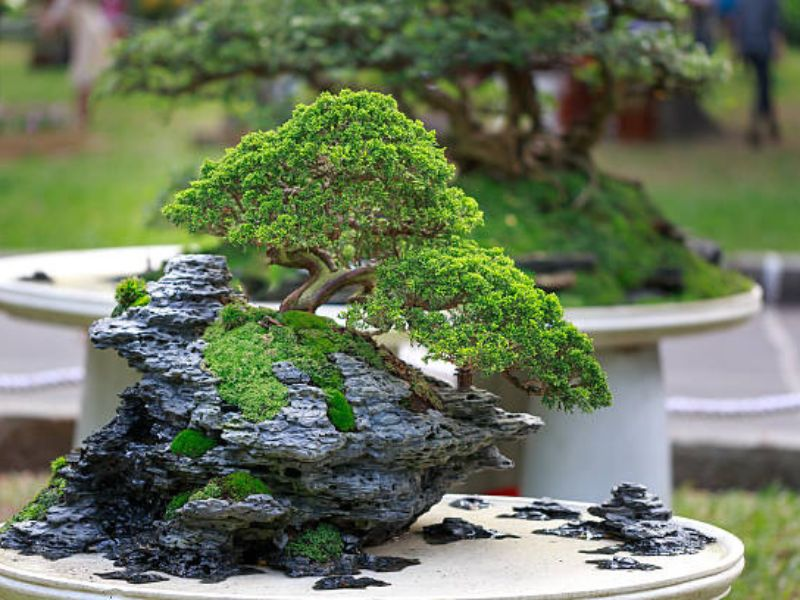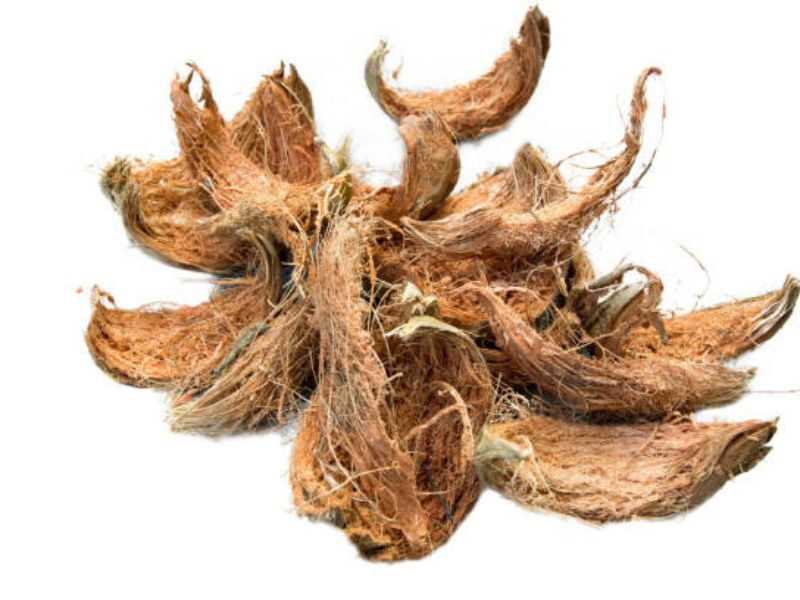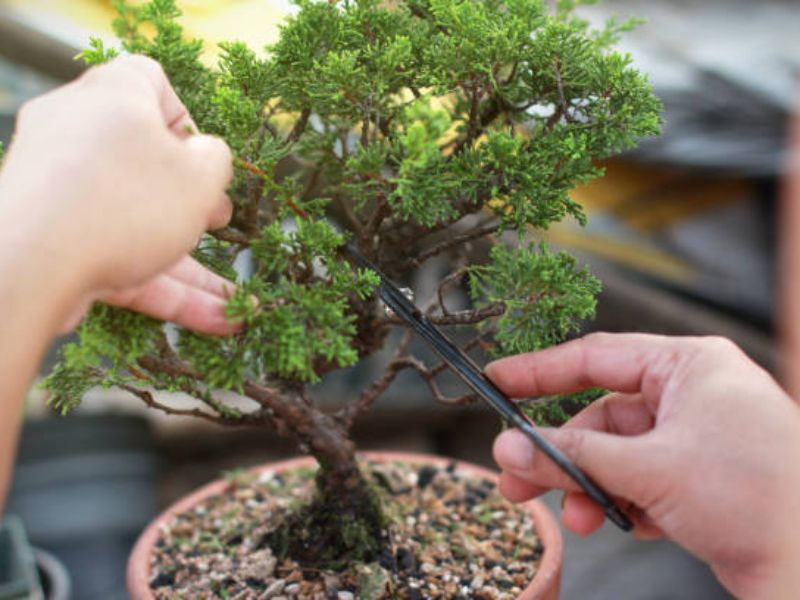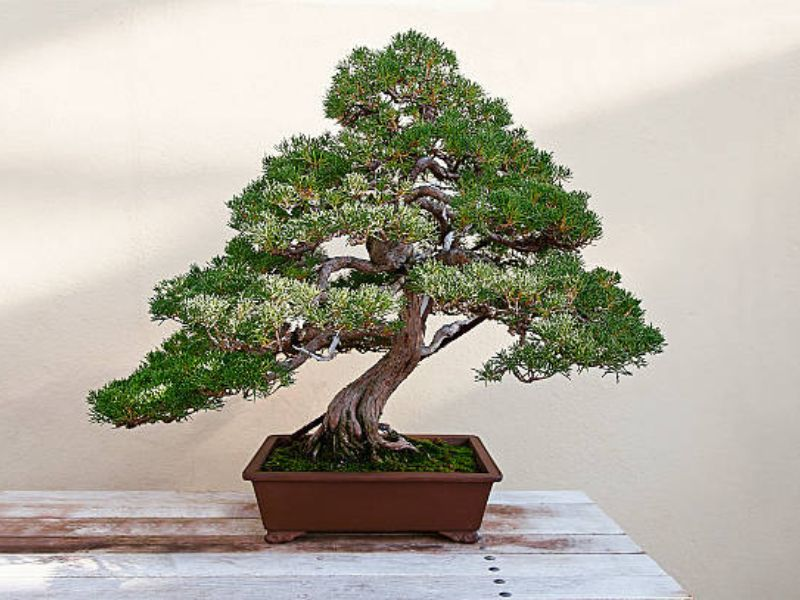Bonsai and sustainable gardening have evolved hand in hand, with the ancient art of cultivating miniature trees deeply intertwined with nature’s rhythm. Bonsai artistry is not just about shaping trees but also about understanding and harmonizing with the environment.
As our world becomes more environmentally conscious, the importance of eco-friendly gardening practices in the world of bonsai has never been more paramount.
These practices not only preserve the delicate balance of these miniature trees but also reflect our broader responsibility to the environment.
The Role Of Sustainable Soil Practices In Bonsai Health
Embracing the principles of bonsai and sustainable gardening, the health and vitality of a bonsai tree are intricately linked to the soil it’s planted in. Emphasizing sustainable practices is not merely an environmental gesture; it directly impacts the long-term health of the bonsai.
Soil that is cultivated sustainably provides the roots with an optimal environment, fostering better root growth, ensuring efficient nutrient uptake, and reducing the risk of diseases like root rot.
In recent years, there’s been an eco-friendly shift in modern bonsai cultivation. This change is driven by a deeper understanding of the interconnectedness between bonsai trees, their immediate environment, and the broader ecosystem.
Modern bonsai artists and enthusiasts recognize that using organic, renewable, and environmentally friendly soil components not only supports the health of their bonsai plants but also contributes positively to the environment.
As a result, sustainable soil practices have become more than just a trend; they represent the future of bonsai cultivation.
Key Eco-Friendly Bonsai Soil Components
Bonsai soil is a world unto itself, with each component playing a crucial role in the health and beauty of the tree. The right mixture can make all the difference, and in the pursuit of sustainability, certain eco-friendly components stand out:
Lava Rock

These natural, porous stones are a favorite among bonsai artists. Lava rock not only enhances drainage, preventing root rot, but it also offers spaces that promote healthy root growth. Its rough texture also aids in anchoring the bonsai’s roots, providing stability to the plant.
Top Dressing
Beyond its aesthetic appeal, a top dressing serves a functional purpose. It offers a sustainable approach to moisture retention, reducing the frequency of watering and ensuring the soil holds moisture evenly.
Common top dressings include:
- Fine Gravel: Often chosen for its neutral colors and consistent sizes, fine gravel allows water to flow through, preventing stagnation, yet provides a protective layer against soil erosion during watering.
- Moss: Frequently used for its lush green appearance, moss also helps maintain soil humidity. It’s especially beneficial for bonsai trees that thrive in moist environments. Plus, moss-covered soil closely mimics the natural habitats of many trees.
- Turface: A calcined clay product, Turface is known for its ability to retain moisture and slowly release it, making it an excellent choice for controlling soil moisture levels.
- Cocoa Hulls: These are a by-product of the chocolate industry and are both decorative and functional. They help prevent soil compaction and retain moisture, all while adding a delightful aroma to your bonsai garden.
- Pumice: Although more commonly recognized as a soil component, pumice can also be used as a top dressing. It’s lightweight, porous, and helps improve aeration, making it a preferred choice for many bonsai artists.
Organic Compost
A key component in any gardening venture, organic compost is particularly vital for bonsai. It’s nutrient-rich, offering essential minerals for the bonsai. Moreover, being environmentally-friendly, it minimizes the carbon footprint of your bonsai cultivation, aligning with the principles of bonsai soil troubleshooting.
Akadama
A staple in traditional Japanese bonsai cultivation, Akadama is a type of clay granule known for its moisture and nutrient retention properties. As it breaks down over time, it releases minerals that are beneficial for the tree, ensuring a balanced nutrient intake.
Coconut Coir

A renewable resource, coconut coir is gaining popularity in bonsai circles. Its fibrous nature is excellent for moisture retention and provides an airy texture, which is beneficial for root systems. Additionally, its sustainable nature makes it an eco-friendly alternative to peat moss.
Biochar
An innovative addition to bonsai soil, biochar boosts soil fertility and has the added benefit of storing carbon, thereby offsetting CO2 emissions. Derived from organic matter, biochar also improves water retention and supports a thriving microbial community in the soil.
Importance Of Proper Drainage In Bonsai Soil
For any plant, proper drainage is paramount, and for bonsai, it’s even more critical. The confined space of a bonsai pot can either be a sanctuary or a trap for the roots, and it all hinges on the drainage.
The Concept Of A Drainage Layer In Bonsai Pots
The art of bonsai goes beyond just pruning and shaping; it delves deep into understanding the very foundation, the soil. One of the primary practices in this art form is the incorporation of a drainage layer at the bottom of the bonsai pot.
Typically consisting of coarse material such as gravel, lava rock, or even pieces of broken pottery, this layer ensures excess water can easily flow out of the pot. It serves as a protective barrier, preventing the finer soil particles from clogging the pot’s drainage holes, thereby maintaining a clear path for water exit.
Guarding Against Root Rot And Boosting Root Health
Stagnant water is a recipe for disaster in the world of bonsai. Prolonged exposure to waterlogged conditions deprives the roots of oxygen, leading to the deadly condition known as root rot. A well-draining soil, complemented by a proper drainage layer, ensures that water doesn’t linger around the roots longer than necessary.
This not only prevents root rot but also encourages roots to grow and spread in search of moisture, fostering a robust and healthy root system. In turn, a thriving root system supports new growth, vibrant leaves, and a radiant overall appearance of the bonsai tree.
The Role of Bonsai Nurseries in Promoting Sustainable Practices
In the realm of bonsai and sustainable gardening, bonsai nurseries play an instrumental role not only in the propagation and sale of bonsai trees but also in laying the foundation for sustainable practices in the world of bonsai.
The journey of every bonsai tree, from its infancy to its majestic form, often begins at a bonsai nursery. These nurseries play an instrumental role not only in the propagation and sale of bonsai trees but also in laying the foundation for sustainable practices and bonsai soil troubleshooting in the world of bonsai.
Choosing Eco-Friendly Nurseries For Your First Bonsai
For many enthusiasts, purchasing their first bonsai is a significant and memorable event. But beyond the allure of aesthetics, it’s crucial to choose nurseries committed to eco-friendly and sustainable practices. These nurseries prioritize organic and sustainable soil mixtures, avoid harmful chemicals, and focus on conserving water.
By opting to buy from such establishments, hobbyists support a larger cause – the preservation of the environment. Moreover, the trees from these nurseries tend to be healthier and more robust, having been nurtured in an environment that mimics nature closely.
Bonsai Artists As Educators In Sustainable Gardening
Bonsai artists, with their deep-rooted knowledge and passion, are more than just cultivators; they are educators. Many seasoned bonsai artists take it upon themselves to impart the importance of sustainable practices to newer enthusiasts.
Workshops, seminars, and even informal discussions at bonsai nurseries can revolve around the best eco-friendly soil practices, water conservation techniques, and organic pest control.
Sustainable Care Beyond Soil: Pruning And Branch Structure

While soil and its components form the bedrock of bonsai cultivation, the above-ground elements – specifically pruning and branch structure – are equally vital. These not only define the aesthetics of the bonsai but also influence its health and longevity. Sustainable care in these aspects is pivotal.
How Sustainable Pruning Promotes New Growth And New Shoots
Pruning is more than just a cosmetic procedure in the bonsai world. When done sustainably, it encourages new growth and the sprouting of new shoots. By selectively removing older, weaker, or overcrowded branches, you’re allowing the tree to channel its energy to robust growth areas.
This results in a bonsai that’s vibrant and full of life.
Sustainable pruning also ensures that the tree doesn’t overexert itself, thus prolonging its lifespan. Using sharp tools, making clean cuts, and knowing when and where to prune are all elements of this eco-conscious approach.
Maintaining A Bonsai’s Branch Structure With The Future In Mind
A bonsai’s branch structure is its story – a tangible record of its journey through time. Sustainable care means sculpting this narrative with a vision of the future. It’s about understanding the tree’s natural growth pattern and guiding it rather than forcing it into a shape.
This not only results in a tree that looks natural but also one that’s healthier. Over time, the branch structure evolves, and with sustainable practices, it does so in harmony with its intrinsic growth tendencies.
Environmental Benefits Of Eco-Friendly Bonsai Soil Practices
In the context of bonsai and sustainable gardening, bonsai cultivation, rooted in centuries-old traditions, finds itself in a unique position in the modern era. With the burgeoning global consciousness about environmental conservation, the practices surrounding bonsai soil can be revamped to have positive ecological impacts.
Here are some of the profound environmental benefits stemming from eco-friendly bonsai soil practices:
Reduced Carbon With Local Soil Components
Shipping soil components across vast distances has both a financial and environmental cost. By sourcing and using local soil components, we significantly cut down on transportation emissions and enhance our bonsai soil troubleshooting efforts by utilizing regional materials.
Additionally, sustainable soil components like lava rock and organic compost have lower carbon footprints in their production processes. When bonsai artists choose local, they’re not only ensuring the best for their trees but also contributing to a greener planet.
Boosting Biodiversity In Bonsai Soil
Biodiversity is the bedrock of a healthy ecosystem. Eco-friendly bonsai soil teems with a plethora of microorganisms, fungi, and beneficial bacteria. These microscopic entities play crucial roles in nutrient cycling, disease resistance, and overall soil health. By fostering this biodiversity, we ensure a resilient and dynamic environment for our bonsai trees.
Water Conservation In Bonsai Care
Sustainable soil components, such as top dressing or coconut coir, are excellent for moisture retention. They reduce the frequency of watering and ensure the soil holds moisture more uniformly. This efficient use of water is a boon in regions facing water scarcity and aligns with global goals of conserving our precious freshwater resources.
Waste Reduction With Biodegradable Soil
In a world grappling with the challenges of waste disposal, using natural, renewable, and biodegradable components is a step in the right direction. Materials like biochar and coconut coir not only enrich the soil but also decompose naturally, reducing landfill waste. It’s a win-win for both the environment and the bonsai.
Bonsai’s Sustainable Future

Bonsai, an ancient art form that merges human artistry with nature’s essence, has always emphasized balance and harmony. Integrating sustainable gardening practices amplifies this harmony, ensuring that our beloved art form continues to flourish without taxing our planet.
The Lasting Benefits of Sustainable Gardening in the World of Bonsai:
- Longevity and Resilience: Eco-friendly practices foster stronger, healthier bonsai trees that are better equipped to handle pests, diseases, and changing climate conditions. With a robust root system supported by sustainable soil practices, bonsai trees are more likely to thrive for years, if not decades.
- Environmental Harmony: Every step taken towards sustainable bonsai practices is a step towards a healthier planet. By reducing the carbon footprint associated with soil transportation, conserving water, and using biodegradable components, bonsai cultivation becomes a positive force for environmental well-being.
- Economic Benefits: Sustainable practices often prove to be more economical in the long run. For instance, local soil components can be less costly than imported ones. Additionally, healthy bonsai trees nurtured with sustainable care require less frequent replacements and interventions, saving both time and money.
- Community Engagement: As the bonsai community shifts towards sustainability, it creates an opportunity for artists, nurseries, and enthusiasts to come together, share knowledge, and learn from each other. This collective shift not only fosters a deeper appreciation for the art but also strengthens the community’s commitment to eco-friendly practices.
The path forward for bonsai is clear: a harmonious blend of traditional artistry and modern eco-friendly practices, including bonsai soil troubleshooting to ensure sustainable gardening. By embracing bonsai and sustainable gardening, we ensure that the legacy of bonsai not only perseveres but thrives in a manner that is kind to our Earth.





0 Comments